Portable
Amateur Radio History,
W7ZOI / 7
W7ZOI/7, Field Day
with KD7LXL, 2002, Near Naches Peak,
Wes Hayward,
w7zoi.
Updates:
4Jan11, 14Jan11, 15April11, 24April11,
27June11, 25June12, 15aug12, 24June13, 28April16,
3July16, 13Aug16, 21Dec16, 28July18, 6May2019
,29june2019, 20Dec2020, 3Nov2021
Click here for reports for Field Day
2011, Field
Day 2013, Field
Day 2016 , UHF
Contest--August2016, Field
Day 2018,
Microwave-Sprint, May
2019, Field
Day 2019, FYBO 2007,
ARRL
September VHF Contest 2002 on Maxwell Butte
All Photos on this website are my own. I took
them, or they were taken by my sons or other
hiking/climbing companions. I've tried to
acknowledge the photographer. None
of these photos are the result of web surfing.
All photos are
copyrighted: If you want to use a photo on
your own site, just write to me about
it. {w7zoi}{at}{arrl dot net}.
Introduction
This web thread deals with portable amateur radio
activities where equipment is taken into the
field. Amateur radio has sometimes
been the main reason for the outing, such as
participation in a contest. Just as often,
the ham gear has been taken along as a supplement
to a hike, a climb, or a backpacking junket.
Some folks also carry their ham gear along
on trips with bicycles, canoes, or kayaks.
All fall into the realm of this discussion.
This site is strictly a personal history of some
of the things I have done and does not deal with
the activity of others in this area.
While many of the photos show operation with
friends and/or relatives, this is not a site for a
specific club or group. All of my trips
have been on foot in the mountains of the US West.
There are other sites on the
Internet that specifically deal with portable
operations and I encourage the interested reader
to investigate them. An especially
good one is SOTA, or "Summits on the Air."
This organization was founded by Richard, G3CWI
and his colleague, G3WGV. Click HERE to
get to the
There is a down side to the SOTA activity:
It tends to emphasize operation from named,
documented summits. There are many parts of
this country where summits of any kind are rare,
yet there is more than abundant opportunity for
portable ham operations, perhaps coupled with
kayak or canoe boating on water. Land
travel may be by foot or bicycle.
Even when in the mountains, it is not
necessary to be on a summit to garner the thrills
and advantages of portable operation.
Often an un-named ridge or pass will provide
views and antenna opportunities that rival those
afforded the summit traveler. I generally
just look for good radio locations (that must also
be scenic) and do not worry about them being a
summit. Alas, by now most of my peak bagging
days are past anyway.
The dominant reason for taking ham gear into the
field is very simple; it is great fun.
But there is serendipity: It is
always good to exercise our skills to be ready for
an emergency. Amateur radio can be
effective in moderately remote mountain locations
where nothing else is available, other than some
expensive satellite services.
There are two additional factors that motivate us
toward portable operation. The first
is the restriction often imposed upon us by our
lifestyle within society. Many folks
live in apartments in cities where antennas are
nearly impossible. (Some folks manage to
get on the air with attic antennas and the like,
but it requires imagination and sometimes a lot of
work!) Others live in developed housing
areas where antennas are discouraged, if not
strictly prohibited. Portable
operation may be the ideal solution for the folks
fighting these restrictions.
The other factor is noise. This is one that
I'm presently fighting, albeit only with marginal
success. The noise comes from the
many electronic gadgets that are said to enhance
our lives. It's hard to find a
household that doesn't have numerous computers
running. This goes beyond personal
computers to include the microprocessors in the
microwave oven and the clothes washer. It
also includes the insidious digital data
converters that supply us with high speed
internet, telephone, and high definition cable
television services. Light dimmers
and touch lamps are other problems.
The noise emanating from these sources is
relatively short range. Some of it can
easily be attenuated merely by walking away from
it. I'm amazed how quiet a band can
become when I walk a mere quarter of a mile into
the woods south of my neighborhood.
Some noise sources are stronger and propagate further.
These can be heard in the local parks, but
completely vanish in the mountains.
It is sometimes quiet on the ocean beaches of the
West, but not always, for they are often close to
civilization.
There is a more esoteric, yet equally important
virtue to portable operation -- it provides an
activity in our lives that instills a sense of
adventure. We need this. Even
as a "geezer," I still yearn for the excitement
that was more common in my youth.
Rock climbing and mountaineering are, alas, little
more than memories for me. But I still
manage to get out for some hiking, modest
backpacking, and even some casual winter snow
shoeing. Portable ham radio is often
part of these junkets. The
radio contacts from the field, even to just the
next state, can be more exciting than the best DX
garnered from home!
OK, so much for the preface -- let's get to the
subject. Some of the things to be discussed
are HF contesting from the hills, including Field
Day, VHF contests, winter operations, and special
events including an interesting, albeit obscure
winter QRP version of "field day". But the
discussion starts with personal history.
First treks
By the time I started
participating in amateur radio (Novice license in
1955) I had already done a little bit of
backpacking, starting with Boy Scouts. Both
interests grew more or less together and it was
reasonable that at one point they would merge.
Both activities continue with me, over a half a
century after they began. My first hike with
radio gear was in July of 1958 with my brother
Den. We hiked to the top of
I had made a sked
(schedule) with George, K7BFI ahead of time,
not knowing if we had a chance of working anyone
else. The transmitter ran about a half watt input
power to a single 3S4 tube powered by a 90
volt "B" Battery while the receiver was a three
transistor regenerative job (see QST, July, 1957,
p36.) My only photos of that trip did not
show the rig or the operation. The rig
itself is also long gone, but I hope to duplicate
it someday. I vividly remember just
how strong George's signals were from the hilltop.
I also recall hearing some weak signals in
the background that I would never have heard from
home. I worked George on both 80 and
40 meters. Noise was absent to a level that
I had never experienced. The same rig was
included on a mountain backpacking/fishing trek
later that summer, but nothing was worked or even
heard. But we had camped at a lake deep in
the woods, surrounded by mountains, so it is not
surprising that nothing was worked.
WA6UVR/6. (1961-1966)
I finished my undergraduate college experience and
got married in 1961 and we left the northwest for
The photo above shows the first time I combined
amateur radio with an overnight backpack and
climb. This was Field Day of 1965. I
was joined by Chuck Wilcox, K6DMW, on a hike up
the north ridge of
This was the rig on
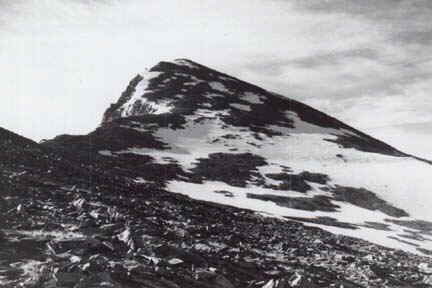
This is the north face of
Again W7ZOI / 7
(photo by Andre' Zoutte, WA7IHJ.)
I'm operating at the left. One fellow was holding
the antenna mast while another steadied the call
pennant in the wind for the photo. Note the
RG58 coax blown out by the wind. While the
temperature was blistering hot over most of the
So what's this
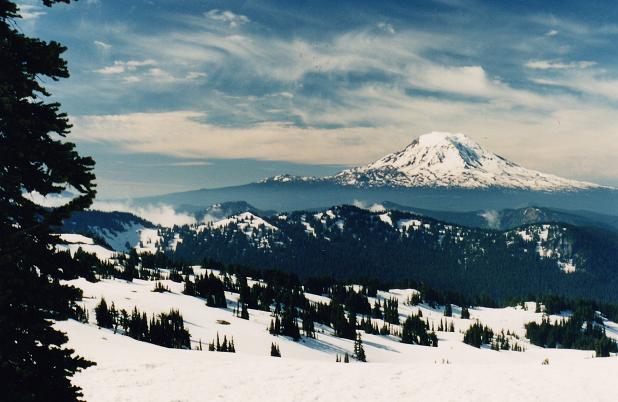
The late 1960s and early 1970s
era included a great deal of experimentation, much
of it related to rigs for the mountains.
Some early direct conversion receivers
resulted from some of this work.
Urges to build portable rigs happened a couple of times
per year. The
"spring" motivation is predictable. But it also
seemed to happen in late fall and early winter
when
Both boxes run an output of about half a watt, a
level that we concluded was about right for an
extended trip (batteries that one can carry) while
still offering reasonable performance. Modern
batteries (year
1990 and on) will easily support higher output
power. Both rigs saw considerable
application in the mountains with the right hand
photo showing the Micro mountaineer in use, Dec
1972. Operation with gloves or
mittens is a must. Both units provided
technical direction for equipment to
follow. The photo of me
operating in the woods was taken by Gene Single,
K7IUN. Incidentally, that photo
was not posed. I was actually working
VE6WG when the photo was snapped.
Commercial equipment continues to
evolve. Consider the photo
below:
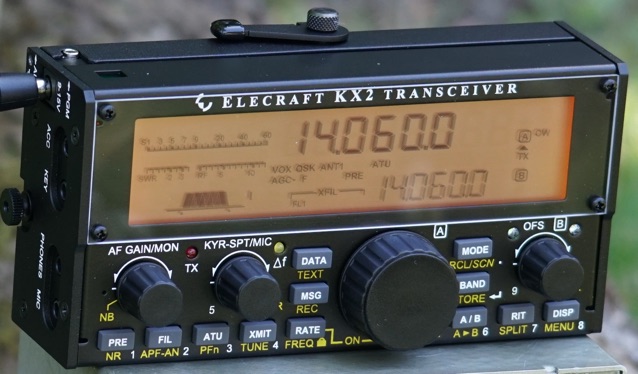 (N7FKI photo)
(N7FKI photo)
This photo
shows a recently introduced, ultra compact and
versatile "trail friendly" commercial transceiver,
the KX2 from Elecraft. (photo taken in June,
2016). This KX2 belongs to
N7FKI. (I eventually bought one too.)
This little box is just slightly larger
than the Micromountaineer
above, weighs just over one pound with battery, offers CW and SSB
plus digital modes, and delivers up to 10 watts.
It's truly amazing how far things
have come.
ARRL Field Day
The ARRL Field Day was often a major activity in
my schedule of Mountain/Ham treks.
These were often collaborative efforts.
Considerable effort was sometimes devoted
to building rigs and antennas especially for FD,
and in the development of some ancillary tools.
The following photo shows a table that
could be dismantled and stowed in a pack.
W7EL/7,
late 1970 time frame. The lower
shelf houses a transmatch and rather heavy battery
while a couple of transceivers and a keyer are on top.
One of the transceivers is one that
was described in Solid-State Design for the Radio
Amateur, p214. (ARRL, 1977) Two clip
boards were used for this operation. One is
for the log while the other is a cross-check
sheet. (By now, we were making enough
contacts that this was necessary.) A half
amp solar panel was included in the mix, although
we later discovered that ARRL ruled it illegal,
for we were using the panel to top off the
storage battery. They wanted solar
contacts to occur without a storage cell. We
had done that often, but not always when in the
field. Oh well.
We were picking up some other lore along the way.
For example, it was vital to include
mosquito nets and/or repellent. But some of
the most effective brands of "bug juice" have the
nasty chemical property that they react with the
classic yellow paint on pencils. So,
we often kept our pencils wrapped in plastic.
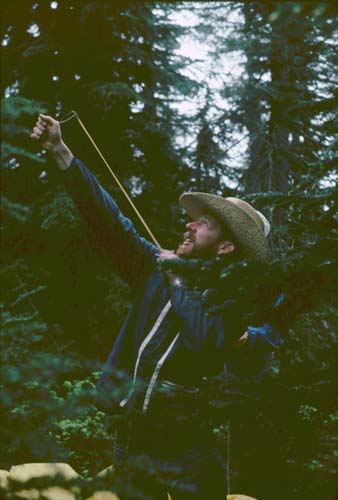 Another
detail
that we observed was the difficulty in
getting lines into the high trees that we often
encountered. We eventually started taking a
sling shot and a spinning reel with medium weight
fishing line. This tool allowed us to get
the antennas up to quite high levels. The
limitation now became the weight of transmission
line that we were willing to pack in. This
photo shows
Another
detail
that we observed was the difficulty in
getting lines into the high trees that we often
encountered. We eventually started taking a
sling shot and a spinning reel with medium weight
fishing line. This tool allowed us to get
the antennas up to quite high levels. The
limitation now became the weight of transmission
line that we were willing to pack in. This
photo shows
By 1989 son Roger
(KA7EXM) had graduated from college and was living
in
This
view shows
Here's Rog, just
after we reached the top. The peaks on the horizon
to the north are around
This is the 40M rig used on McLoughlin,
a direct conversion transceiver running about half
a watt output. The transceiver has a
couple of crystals built into it, but also has a
VFO that can be used. The VFO is the box
riding "piggyback" on the transceiver. The
smaller box is a transmatch. The red
enclosure houses C sized NiCad batteries.
Our "table" was rock at the top of the peak.
The right photo shows a stuff bag housing
the entire station. The collapsed antenna
mast is 14 inches long, but expands to 12 feet; it
supported an inverted Vee
fed with RG-174 coax. This is the same
support used on Adams and Dana. Many thanks
again to Chuck, K6DMW, for that 1965 contribution;
it has certainly been used a lot!
The left photo above shows the 40 M rig with
This
was our high camp on top of McLoughlin.
We used bivouac bags instead of a tent.
One
can see some unusual things when camped on top of
a peak. Here we see the shadow of our peak
at sunset.
McLoughlin was an
excellent radio location offering a comfortable,
single propagation hop on 40 M to much of the US
West Coast. With only half a watt output,
we still made a pile of contacts.
While we tend to think of the summit of a peak or
pass as being the ideal location, that is not
always true. On one trip, Roger and I ended
up in a stand of trees well below the pass that
had originally been picked from studies of the
maps. The pass just looked too hostile as a
camp place, especially in the rainy weather we
were experiencing.
The pass is at the right edge of the left photo
above while our eventual camp is shown on the
right. This shot shows me (well, my boots)
operating in light rain. This location
turned out to be especially good, for the slope
behind and below provided a lower angle launch to
the east than we would have obtained from the
pass. (Roger and I crossed that pass a few
years later.) See the now classic
book by Moxon for a
discussion of dipoles that are below the summit.
(L.A.Moxon,
G6XN, "HF Antennas for All Locations,"
RSGB, 1982.) That location
would be a good one for a return trip. Hmmmm.... Roger?
Note that we were camping on snow. This is
a common situation for FD, which happens early in
the summer backpacking season. Snow
normally presents no problems so long as some
insulating pads are included for sleeping and
operating.
Through the 1970s I often did FD with Jeff,
WA7MLH. Sometimes we cheated and operated for a
few hours from a location that was close to the
car, although it always made us feel guilty. On
other trips we went to the south side of
WA7MLH
The gear shown above is a pair of CW transceivers
for 40 and 20 M that I used. Jeff had taken
rigs along for DSB. He has amassed a great
deal of back country experience with SSB and DSB
at powers from less than a watt up to about 30
watts. Click HERE
to see Jeff's most excellent web site
about his appliance-free shack.
Some of the Field Day trips outlined above take on
mini-expedition characteristics with a lot of
planning and a lot of junk to pack into the hills.
FD can equally be a casual event
where a minimal rig is thrown into a rucksack and
taken out for the day. A FD of this type
was to
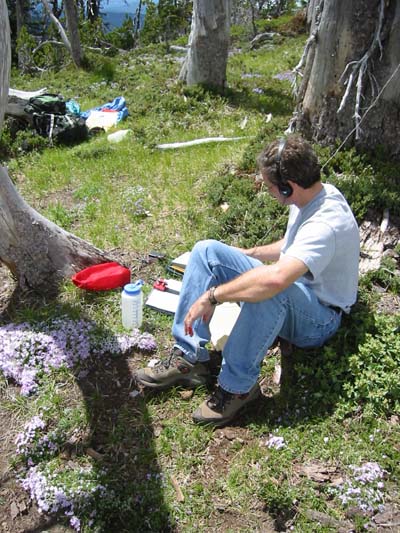
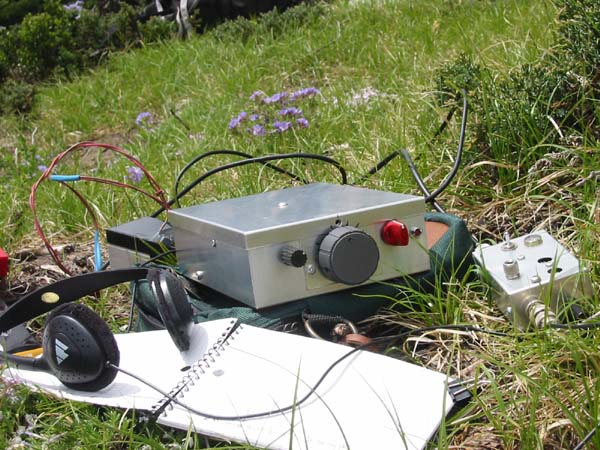
The left photo shows Rick listening to my
transceiver while the right shot shows the rig and
log book.
This is a
1996 Field Day shot of yours truly making a few
final contacts before the antenna was taken down
and we hiked out. The weather had
been good, but it was starting to rain lightly by
the time this photo was taken. This was the
last contact before the log book and the gear was
shoved into the pack for the hike out.
(KK7B
Photo.)
The photo above features my grandson, Tom, KD7LXL,
digging into his pack to find a rig to go with the
antennas we just erected. This was on FD of
2002. The lead photo at the top of this
page is also from that 2002 trip near
Field Day with Single
Sideband
I'll admit to being a hopeless CW enthusiast.
Like most of the kid hams I
encountered when I was in high school, I got my novice
license with the thought, "Well, I'll learn the
code to get my General and then I'll get on
phone." But like many of us, I got hooked
on the excitement of CW, especially when I
discovered how much more I could do with simple CW
gear compared to simple phone gear. Times change.
I'll admit that I've had a lot of fun
building SSB gear. It's been fun to design
it, get it going, measure it, and put it on the
air. But I still don't enjoy SSB operation
as much as I do CW, even today.
I've operated SSB with low power during Field Day
on a few occasions and it has been a lot of fun.
Shown below is a 1997 operation at a park
about a 10 minute hike south of home.
This transceiver operated on the 40 meter band
with an output of about 1.5 W on both SSB and CW.
While this may seem like an excessively low
power for phone operation, it was still quite easy
to make contacts on Sunday morning of Field Day
weekend. The SSB transmitter included
speech processing in the IF. Although the
SSB experience was fun and successful, it was even
easier to make CW contacts with the same antenna
and power output. Often the CW
contacts were much further away than those I did
with SSB. At home, this rig was
used with an outboard 20 W power amplifier that
greatly enhanced the results.
See Experimental Methods in RF Design
(EMRFD, ARRL, 2003) and QST December, 1989 and
January, 1990.
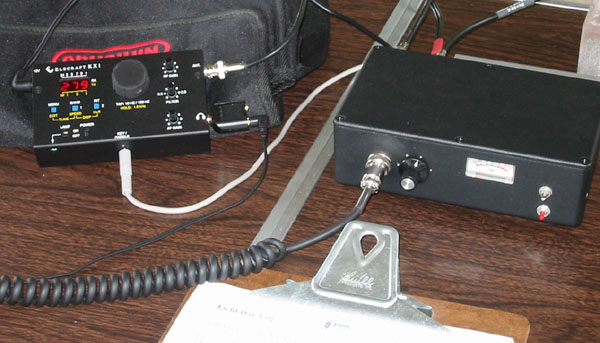
The above shot shows an unusual SSB station, this
one for the 20 meter band. This was the
brainchild of a good friend, Bob Culter, N7FKI. Bob
has an Elecraft KX-1 multiband CW transceiver.
One of the bands is 20 meters. Bob
realized that the internal menus would allow
considerable latitude in offsetting the nominal
carrier frequency from that received. With
this freedom, it was possible to use the
transceiver in the receive mode to copy SSB, but
to then use the transmitted carrier as injection
for a phasing transmitter. Bob based
the transmitter on KK7B designs, but with RF
circuits redesigned for the 20 meter band.
He then built a linear chain ending in a
Mitsubishi RD16HHF1 MOSFET running about 8 watts
output power. The speech processor in Bob's
rig used an Analog Devices SSM2167 integrated
circuit. The rig was much more effective with the
speech processor in operation. This Field
Day operation occurred on the playground of an
elementary school close to Bob's house.
Tom, KD7LXL, and I used some SSB on 15 M with his
Yaesu FT-817 during FD
for 2002. That was close to a maximum
in the sunspots and conditions were
outstanding. We worked quite a few folks
around the US while using nothing more than the 5
watt transmitter output with a 40 meter dipole
about 10 feet above the snow. See the lead
photo for this web article.
Other Seasons
Field Day is always fun, but amateur radio in the
back country is certainly not restricted to that
one weekend. Often, Field Day weekend is
too early in the season to get to the interesting
locations in the western states, for the roads are
still snowed in. This varies, year to year.
Later in the summer is usually more
practical, but does not fit with the amateur radio
calendar. In addition, the trips
later in the summer are often reserved for more
intense backpacking efforts and may not include
ham gear. This leaves the most of the
rest of the year for ham treks. Spring and
autumn are both good. Some of the best
radio trips I've done have been in winter.
The earliest of these was a snowshoe trip to
Here's a photo looking into the entrance of an
abbreviated snow cave that I dug on a mid 1980s
solo trip. The transceiver is sitting on "the
roof," right after keeping a sked
with WA7MLH. It was a kick to work Jeff from the
field after I had worked him so often from home
with him in the hills. Setting radio aside,
the mountains are a special place in wintertime
with an intense quiet that becomes hard to imagine
after the busy, crowded world we normally
experience. A quiet radio environment adds
to the enjoyment. The contacts are
also fun and often unusual. Imagine an early
dinner, followed by retirement to the warmth of a
down sleeping bag with the transceiver and
batteries pulled inside where the wonder of it all
is described in the language of CW to the folks
who are still at home.
This shot shows another quasi-snowcave.
Even without a roof, the shelter
trench offers a warm place to relax and protection
from the wind. Roger and I dug this
one while on a day trek on snowshoes. The
goal for that trip was to exercise a new rig in
the field. The rig was an updated version
of the Micro mountaineer, later presented in QST,
July, 2000. The trip was in February,
2000. The larger item on the cave shelf was
a stove to make soup for lunch. It's
amazing how much warmth is provided by a shelter
like this that is dug in only 10 or 20 minutes.
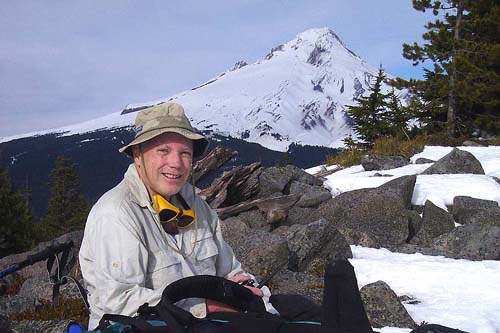
Here's another shot of
VHF Portable
Among the great virtues of being in the mountains
is the great panorama presented. The
most obvious vista is the visual one, but the mountains also
provide an extended radio vista, one that is
especially useful at VHF. It's a
thrill to operate from a slightly rare grid square
that is a long distance from population centers
and to generate pile ups on the VHF bands.
Over the last dozen or so years I've had
the pleasure of going on several expeditions with
son Roger, KA7EXM. He has managed to put
several interesting grid squares on the air and to
make some very interesting, relatively long haul
VHF contacts. The modes that he has used
are CW and SSB, all with QRP power levels.
We always use his call on the VHF
expeditions.
(Photo by either KA7EXM or WB6JZY.
TNX guys.)
Roger and his work colleague Jack Trollman, WB6JZY, near the
summit of
Roger's VHF antennas are generally Yagis for 2M and up.
A simple dipole is used for 6M. The
6M activity is not usually featured, but is
sometimes included merely because his main
transceiver, an
FT-817, includes that band. The VHF Yagis are those described
by WA5VJB. See the articles in CQ VHF,
August 1998 and October,
1998. Roger has built these antennas
for 144, 222, and 432 MHz with excellent results.
He uses a homebrew transverter
for 222 MHz. See the article in QST by
W1GHZ, January, 2003.
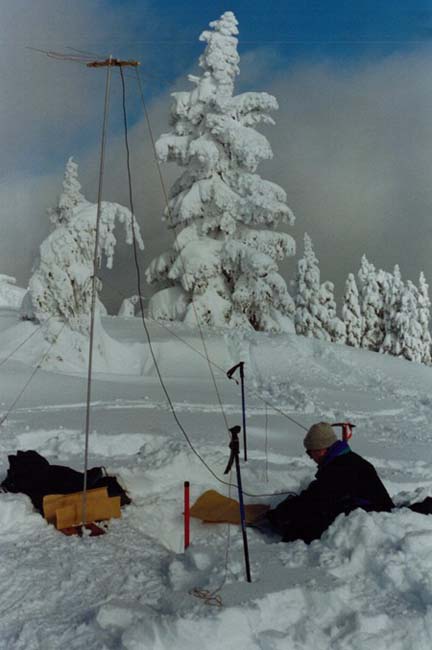
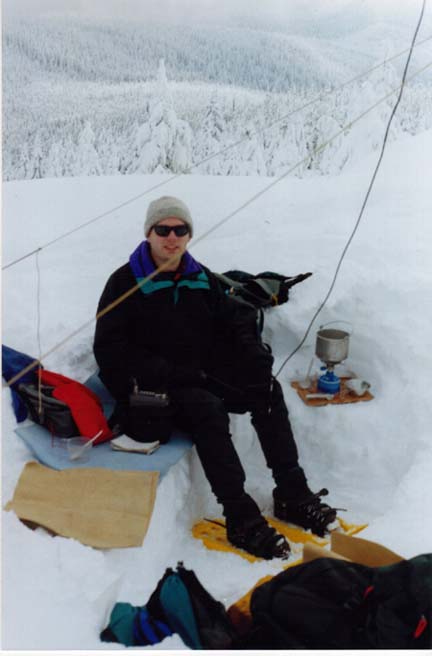
The above two photos show Roger working folks back
in
This
photo of Roger is from another VHF SS trip to the
same general area on the Pacific Crest Trail.
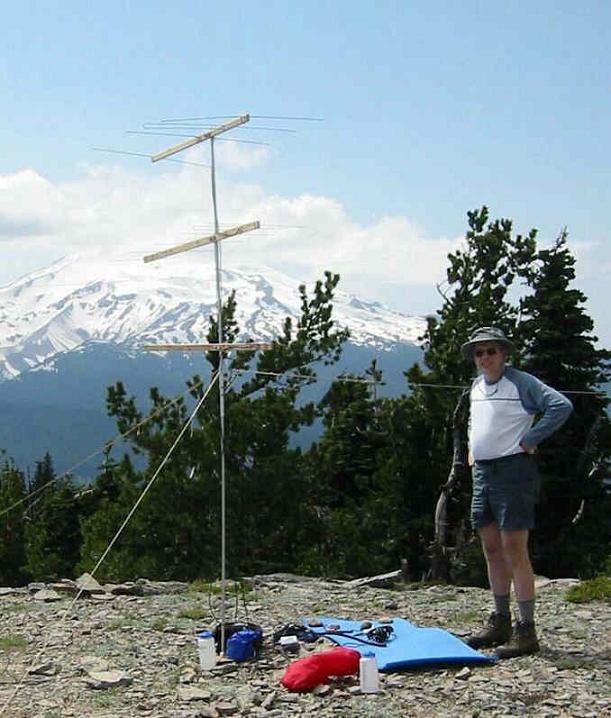
Roger on the summit of
Roger keeps an on-line list of his VHF portable
activity. Click HERE
for that list.
Here are a couple of shots of Roger on a trip we
took to "tie in rock" above the Elliot Glacier on
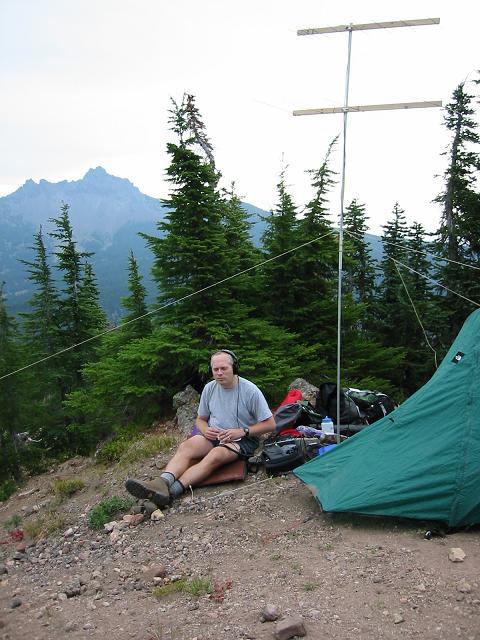
One of the best VHF mountain
topping treks we did was to Maxwell Butte in the
Mt. Jefferson Wilderness Area of Oregon.
Here's Roger working a few guys on 144 MHz CW.
For more info and more photos on this trip,
click here.
The ARRL approach to VHF contesting
differs from that used for Field Day. The
FD rules include a "Class B" where one or
two people can operate a single
transmitter station. This class adapts
itself well to backpack contesting efforts.
In contrast, the VHF contest rules have a QRP
class, but restrict it to a single operator.
Because of this, I have rarely participated
in any actual station operation on our VHF
junkets. There have been moments
where I would love to have operated a little, but
it is a "single operator" event. Oh
well. One approach is to go into the
field, work the contest, but to never submit a log
or score. Rules don't really matter
then. The down side of this is that the
published results are not then representative of
the actual activity. Even this is of little
consequence owing to data-mining that happens with
submitted logs.
All of our efforts have been with SSB and CW.
These modes are clearly preferred for long
distance weak signal applications. FM can
still be effective if the location is good enough.
FM is also a very useful tool for
communications within a group that may be spread
out on a trail.
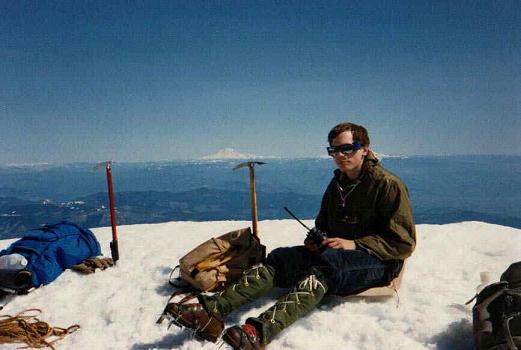
An outstanding location for any mode is the summit
of
UHF Portable
Our main emphasis has
been simple HF CW operations. However,
son Roger has become quite interested in portable
operation with VHF gear. His
experience has taken him up through 432
MHz. (Cell phones don't
count!) We recently joined John,
K7CVU, on a hike to a location that we have
visited in the past. But this time we
took UHF gear. John had a transverter that ran 2.5
watts output at 1296 MHz. His
antenna was a 5 element Yagi
that we put atop a small backpacking camera
tripod. The IF for the transverter
was a Yaesu
FT-817.
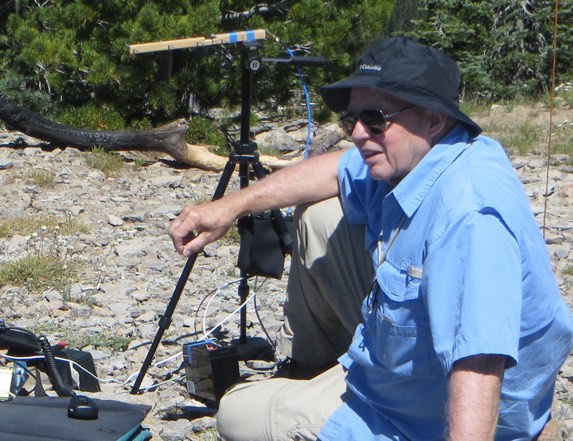 Here
we see K7CVU in 2008 with his 5 element 1296 MHz Yagi. This
provided contacts as far away as 168 miles.
I suspect that we will try to do more
at UHF, for this was extremely fun.
Click here
to read about this trek.
Update: We did another UHF mountain top
trek, this time in May, 2019. The location
was the Coast Range of Oregon. John
added 2304 MHz this round. Click here to
read about that one.
Here
we see K7CVU in 2008 with his 5 element 1296 MHz Yagi. This
provided contacts as far away as 168 miles.
I suspect that we will try to do more
at UHF, for this was extremely fun.
Click here
to read about this trek.
Update: We did another UHF mountain top
trek, this time in May, 2019. The location
was the Coast Range of Oregon. John
added 2304 MHz this round. Click here to
read about that one.
Equipment Thoughts
Often folks will ask about rigs for portable
operation. There are many choices
these days including a number of high performance
kits. I still prefer to brew my own.
The experience is then more complete with the
operation becoming an extension of the experiments
that led to the gear.
I presently have several 40 M CW rigs that I take
to the mountains. One is a VFO
controlled superhet shown below.
This transceiver runs 1 watt output and has
several features built into it including a
frequency counter and keyer.
The string of Ni-MH batteries
shown will power the rig for a typical
weekend of operating, if not longer. (The
heavy keyer paddle
shown is only used at home!)
The front panel LED ceases to function if
the battery voltage drops below 11.5. The
transceiver weighs just over 1 pound with a
receiver current consumption of about 35 mA.
Click HERE
to see the schematic for this rig.
Similar gear for the 14 MHz band features improved
performance with more power and a stronger (higher
dynamic range) receiver front end. This equipment
is described in Experimental Methods in RF
Design ( EMRFD,
ARRL, 2003).
Commercial gear for the VHF bands is readily
available although it is not as common as that for
HF. One popular offering is the Yaesu FT-817. The
performance has been completely satisfactory, with
one major exception: The FT-817 eats
batteries alive. On the mountain top
contest activities, we have often carried an 8
Amp-Hour Sealed Lead Acid battery to run the
FT-817. Starting with a full charge, it is
depleted by the end of an overnight contest.
The problem is not high transmit power.
Rather, it is the excessive current consumed at
all times. This results from the use of
relays for all band switching. The
FT-817 is a good choice if the operating interval
is short.
A much older monoband
rig offers performance that is, in many ways far
superior to the later multiband designs.
This example is a classic 2 M SSB/CW rig, the
IC-202 from Icom.
While the rig itself weighs more and is
larger than the FT-817, the total weight per watt
is much less when batteries are included.
Receive current for the IC-202 is around 70
mA, so it will last
for an entire contest with a set of internal
C-cells. We have also had good luck with a
Mizuho MX-2. This little rig produces a
couple of hundred mW
of SSB and CW output in a package the size of a
traditional 1980s era FM hand held.
The Mizuho uses a convenient 9 volt supply.
One portable rig from
Elecraft, the KX3, is also
noteworthy. This box provides CW
and SSB on all HF bands plus 6 Meters.
A 2 Meter internal transmatch is an
option. This box is quite light
weight and has low current consumption and would
be an option. A cousin to the
KX3 has just (2016) been introduced, the KX2, and
it is even smaller and lighter.
However, it covers fewer bands.
There is clearly justification for brewing one's
own rig for the VHF bands. Numerous
examples are included in Experimental
Methods in RF Design (EMRFD, ARRL,
2003) to serve as a starting point.
Several variations of a phasing transceiver
for 2M are shown in Chapter 12. A
Universal Monoband
Superhet Transceiver is presented
in Chapter 6 (see page 6.83) with
the one shown operating in the 6M band. It
could be built for any HF band or even for 2M
merely by changing some LC filters and the LO
chain. That rig has been a great
performer, yielding sporadic E contacts from W1 to
Homebrewing will
become necessary as we move to
UHF. Some commercial FM gear is
available for 1296, and imported SSB/CW transverters are
available. But there is no turn-key
solution available. Perhaps this
is part of the lure of the 1296 MHz band?
How Heavy is the Pack?

This photo shows a vital part of the game, that of
at-home testing before taking the gear into the
field. In this case, the total weight of
the station is determined with a kitchen scale.
It's coming in at about 2 pounds, or
a kilogram for the set up shown. Note that
the keyer paddle,
earphones, and battery are included with the
transceiver. The antenna system must also
be included when planning for portable outings,
for that is part of the pack load. After
the "weigh-in," the equipment should be set up and
used, taking care to add nothing more than the
gear that was on the scale. There is
an old adage for backpacking that says "Worry
about the ounces and the pounds will take care of
themselves." This clearly applies to the
radio gear that will be carried into the field.
It is very important to use the gear at home just
as it will be used in the field. If a
commercial rig is to be used, try to set the menu
items at home so that frustrations are avoided
once on the hill. This is, of course,
not a problem with homebrew gear used by the
builder, for he or she will know how the menus
function!
Some popular antenna solutions can be excessively
heavy. The telescoping 12 foot antenna mast
that I've used for many years weighs about 2
pounds. It easily fits in a pack and is
very robust, so it has been a reasonable solution
when traveling above timberline where there are no
trees. A better solution is a modern
fiberglass crappie type fishing pole that expands
to a 20 ft length. It weighs only one pound.
It is the preferred solution and is popular
with many QRP radio amateurs taking gear into the
field, although it does have the disadvantage that
it is still long when collapsed.
The one I have is 45 inches, so it won't fit
inside a pack. It is easily strapped to the
side of one though. A wonderful telescoping
mast is available that expands to 33 ft, or 10 M
length. It's a great thing if one is going
to do an automobile bound portable stint.
But that mast weight is 3.5 pounds, making it of
marginal utility for most backpacking.
These pack weight comments are predominantly
"geezer" considerations and should not be regarded
as limitations by younger hams or those used to
hauling heavy packs. We hauled large
loads in our youth and a few extra pounds in the
pack made little difference then. But times change.
Most of us tend to be more concerned
about pack weight as we add a few years to the
tally.
Final Thoughts
Finally, a word of
caution: The activities presented
here are avocations that we have, by now, pursued
for over 60 years. They are not extreme and
certainly do not compare with the feats of the
modern 21st century backpacker or mountaineer.
They can still be more demanding than
a trip to the back yard or local
park. If these activities are new
to you, by all means go with someone who has done
them before. Always take the right
equipment and know how to use it before you arrive
in the woods. Beware of some of the casual,
small packs that are sold to the QRP community.
These are sometimes found at hamfests or ham-equipment
stores. Some of these packs have no room
for anything other than the intended rig.
Know about the backpacking "Ten Essentials"
and always carry them with you when in the back
country. (Ref: Mountaineering:
The Freedom of the Hills,
Seattle Mountaineers, 1st
Edition published in 1960. The 7th or 8th
edition is in print at this time and is still a
great book.)
With that said, give some portable operation a
try. Even if it is just to a local park, it
can still be quite exciting and great fun.
Indeed, it may be the most fun that you will
ever have in amateur radio. That's been the
case with me.